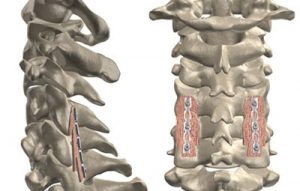Posterior Cervical Fusion Surgery
For Neck Pain Relief
A posterior cervical fusion surgery (done from the back of the neck) provides stabilization of the neck. It may be performed to supplement an anterior fusion of the neck or without any other fusion on the neck, by itself or in conjunction with a cervical laminectomy. The procedure is done through a vertical incision in the neck using a microscope to provide excellent visualization of the nerves.

This surgery is generally performed to:
• Stop the motion between two or more vertebrae
• Recreate the normal curve of the cervical spine and keep a spinal deformity
from getting worse
• Stabilize the spine after a fracture or dislocation of the cervical spine
Before the operation begins, the anesthesiologist will put the patient to sleep. The patient will then be turned on to their stomach in the operating room. This is done in an extremely careful manner to protect all pressure points. The head is placed in a special fixation device known as a Mayfield.
After the appropriate antibiotics are given, an x-ray may be used to guide the placement of the incision in the midline. Once the lamina or roof of the spinal canal is divided, the facet joints are exposed. After drilling holes into the lateral portion of the spine, screws are inserted into the lateral masses. Rods are then used to connect the screws together. This provides stabilization of the spine.
Although the placement of screws into the lateral masses of the spine in the neck is not approved by the FDA, the procedure is commonly performed and has helped thousands of patients.
Patients are generally discharged to home one to three days following surgery. There will also be pain around the incision and at times spasm of the neck muscles. Medications will be given for this. This should improve within one to two weeks after surgery.
Patients should keep their neck incisions dry until they are seen in the office generally seven to 10 days after surgery. They should try to avoid any bending, lifting or twisting for four to six weeks. Depending upon the type of work they do and how strenuous their job requirements are, they may return to work within four to six weeks with some temporary restrictions.
Risks of the surgery are generally low. Potential risks include bleeding, infection, nerve injury, spinal cord injury, and spinal fluid leak.